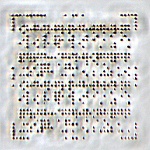When CDs and DVDs were introduced they were the most advanced forms of data storage, yet even they only last for so long. In response, researchers have begun testing other options, most notably glass. When thinking about data storage, glass doesn't usually come to mind, nor any possible connections between them. So, how can glass be used as storage for data? Glass has a reputation for shattering, but it is actually one of the strongest materials on Earth. This characteristic is the target of the research.

Quartz glass is especially renown for its resistance to breakage. Is is any wonder that researchers in Japan have chosen to use it? They've discovered a way to imprint binary code in the form of data dots in the glass. Data dots are microscopic dots which can contain anything from vehicle id numbers to pin numbers and beyond. The proposed lifetime of this combination of glass and data dots is said to be millions of years. The thought is that this data will be prevalent to future generations. As for the capacity, research is still be conducted in order to increase it, but it currently stands at around 40 megabytes per square inch. That's about the capacity of a CD.
Other researchers have been hard at work with this concept as well. Their product is is called monolithic glass space-variant polarization converters. If you think the name is a mouth-full so is the process. In this case, the converters are imprinted on silicon glass. Through the use of polarization and a laser voxels are formed. These voxels house data in the form of tiny figments of light. What is more, this data can be written, wiped and rewritten multiple times so one piece of glass can be used for all kinds of data.
Although it does not use glass, the M-DISC is worthy mentioning as it also uses a hard layer to preserve data. The M-DISC stores data the same way as DVDs and CDs and it's essentially a regular DVD save for a layer of hard inorganic material which houses the data. The proposed lifetime is 1000 years, and while none of us will be alive nearly that long, the M-DISC is much more practical for the everyday user. Instead of needing special equipment this storage system can be used in existing DVD drives including DVD players.
In the end, it's all of matter of the glass acting as a catalyst by which the data is preserved. Yet, a question arises. Why glass? Probably because a microscope is needed for the Japanese version and a laser for the voxel version. The transparency of glass would serve this purpose. Nevertheless, another material can be used, as seen in the M-DISC, so it begs the question, what other materials could be used? We'll just have wait for new discoveries in data storage.
Web. Mobile. Open Source.
Accomplish your software projects fast with our experience.
Get A Free Estimate
